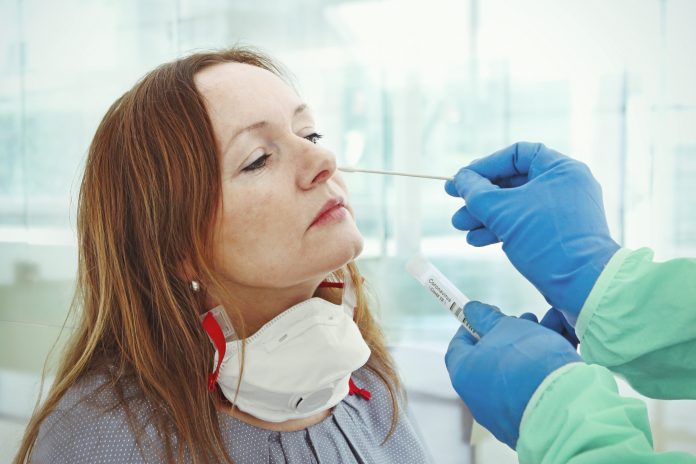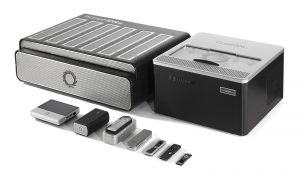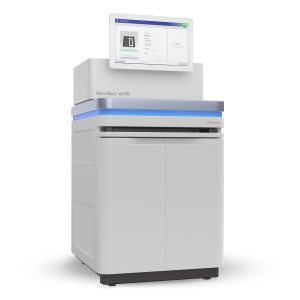
The standard technique used for COVID-19 testing in the United States, from the first cases to today, has been the reverse transcriptase-PCR (RT-PCR). The first diagnostic test for COVID-19, developed by the Centers for Disease Control and Prevention (CDC), received Emergency Use Authorization (EUA) by the U.S. Food and Drug Administration (FDA) on February 4. Since then, many other companies have developed their own similar kits, including Roche Diagnostics, Thermo Fisher Scientific, Hologic, BGI Genomics, and LabCorp to name a few. Despite contamination issues, long turnaround times, shortages of both tests and swabs, and other challenges, the RT-PCR method has remained the workhorse of COVID tests since the beginning of the outbreak.
RT-PCR, which uses primers directed to areas of the SARS-CoV-2 genome to detect the virus, works well when done correctly and without contamination—but there is room for improvement. The test is cumbersome and requires both trained professionals and expensive equipment.
Some groups, for example those developing antigen tests, are focused on bringing the price down. Others, like the controversial ID NOW rapid COVID test by Abbott, are focused on speed, with a goal of providing results on the scale of minutes, not hours or days. Others, like the CRISPR diagnostic companies Sherlock and Mammoth, could (in the long-term) develop a test similar to a pregnancy test—with a line indicating a positive COVID-19 test result. Most people would like to move away from the nuisance of using swabs for sample collection. Not only have swabs been hard to obtain for some, but nasal collection requires healthcare professionals, and PPE for those people. The ability to use saliva for testing is an easier and safer method for collection. All told, the tests that are beginning to emerge now, just five months after COVID-19 testing started in the U.S., have improvements that could change the landscape of future testing for COVID-19 and other infectious diseases.
One new player on the COVID-19 diagnostic scene is the use of next-generation sequencing (NGS) to detect the SARS-CoV-2 virus. Illumina’s COVIDSeq test on June 9 became the first (and remains the only) NGS test granted EUA approval by the FDA. But genomic sequencing is a field that is used to being crowded, and the COVID-19 diagnostic sector likely will be no different.
Why use NGS to test for COVID-19? One obvious answer is to obtain the sequences of the infecting viruses. This allows variants of the virus to be tracked as they spread—yielding information about transmission routes and times, informing best practices, and public health decisions to curb the pandemic. Genomic sequence information may prove particularly useful as borders start to open and travel resumes.
Having the viral genome sequences from more of the tests being performed every day in the U.S. (which are currently being done at a rate of 500,000 per day) would change the landscape for researchers who track and analyze the viral sequences to garner information on transmission and genomic variation.
“Too few samples from infected individuals are currently being sequenced, and essentially no environmental samples are being tested,” Ginkgo Bioworks, a synthetic biology company, notes on the company’s blog. “The ability to perform sequencing at enormous scale to enable population-level testing and long-term surveillance, is needed.”
“I think there will be a lot of [sequencing], especially in the fall, for large-scale efforts to track the virus, and the mutational profiles are key for diagnostic and vaccine development,” says Chris Mason, Ph.D., associate professor at Weill Cornell Medicine, when asked if NGS for COVID-19 testing may have large-scale adoption.
Tensions run high
Many of the companies in the NGS space for COVID-19 testing, perhaps surprisingly, are not yet focused on sequencing viral genomes. Instead, establishing NGS tests for widespread COVID-19 testing is aimed at increasing the amount of detection, rather than generating a lot of sequencing data. Indeed, Ginkgo has noted their aspirations to run a half million tests a day.
And fulfilling the promise of testing such large numbers of people cannot come fast enough for those in the trenches now. For people working in hospitals, what is needed is more testing, and as quickly as possible.

“I don’t see any advantage [of the NGS tests] for a clinical lab… unless they are able to scale up the tests quickly, in a really significant way,” says Susan Butler-Wu, Ph.D., an associate professor at the University of Southern California’s Keck School of Medicine and director of a clinical microbiology lab in Los Angeles County. She adds that there need to be sequencing analyses of strains over time to ensure that the targets of assays are not affected by mutations. But right now, “with a large number of patient samples coming into hospital labs every day, the name of the game is getting results quickly.”

Keith Robison, Ph.D., long time genomics blogger at Omics! Omics! told Clinical OMICs that there will always be a tension between the throughput of testing and the ability to sequence, based on the expense. Given a budget, you will always be able to detect more people if you forgo sequencing. He adds that once the testing is established at a large scale, the sequencing can be added in later.
The nice thing about the NGS assay, says Robison, is that it has an ability to “flex” that the current RT-PCR assay lacks. For example, the NGS test could be modified to pick up a viral sequence with a particular variant. In addition, the NGS test could run with a different amplicon panel designed to detect multiple respiratory virus pathogens from the same sample.
Testing anytime, anywhere
COVID-19 infection knows no bounds. Thankfully, the British company Oxford Nanopore Technologies (ONT) is well known for building a portable sequencing technology that is able to go just about anywhere (even into space). And, the development of LamPORE—a “rapid, low-cost and scalable assay for the detection of SARS-CoV-2”—aligns nicely with that goal.

The test combines Loop-Mediated Isothermal Amplification (LAMP) with nanopore sequencing. LAMP was developed by a Japanese team at the Osaka University Medical School two decades ago. Performed in a single tube, at the constant temperature of 60° C, LAMP is a cheap way to amplify DNA quickly with high specificity and efficiency. After the amplification, the sample is ready for sequencing using ONT’s platform.
ONT notes that up to 96 samples can be processed in just over an hour on a single MinION flow cell. Using more barcodes and a few more hours, they can sequence 1,152 samples on the MinION. The test also checks the sensitivity and limit-of-detection (LoD) box. Robison notes that ONT has presented data suggesting that “LamPORE will be a serious contender on LoD.”
The LamPORE assay is still in validation phase and will shortly be made available for research use only. Although it is being used on RNA extracted from swabs, protocols to detect from saliva are in the works as well.
First to the plate

It may come as no surprise that the first NGS test approved for use by the FDA is from Illumina. Its COVIDSeq test detects 98 targets on SARS-CoV-2 for highly accurate detection and can produce 3,072 results in 12 hours on the NovaSeq 6000 System. The large NovaSeq is one of the newest of the production scale sequencers offered by Illumina. Its niche role (and large price tag) might be considered by some to be constraining. Not only do clinical laboratory personnel running the COVIDSeq test have to be trained in NGS, they also need to be specifically trained in the use of the Illumina NovaSeq 6000 Sequencing System. Taken together, the COVIDSeq is not going to be testing outside big testing centers in well-funded environments. But for centers with NovaSeqs and access to large quantities of patient samples, the large testing capacity could make a huge difference in COVID-19 testing in those arenas.
Robison says that these large-scale platforms may bump into another roadblock that has nothing to do with the sequencing, but with processing the patient samples. He notes that getting from a patient sample to an automated format is “a non-trivial lift.” He explains that when thousands of patient samples come in as swabs in tubes, and they have to be processed and arrayed onto the automation, the logistics of handling the samples is “just brutal.”
Long-read support
Pacific Bioscience’s (PacBio) SMRT technology generates highly accurate and long HiFi reads, which may be particularly well suited to studying viral genomes. These qualities can be useful when fully characterizing all the variants within a viral population or for mutation phasing. Phasing information allows researchers to understand if the genome has mutational hotspots or regions of stability, both of which are important factors in vaccine and drug design. PacBio’s sequencing also allows for detection of rare variants linked to immune evasion or drug resistance and can yield insights into viral evolution, either within the course of an infection of one person, or over time within a community. PacBio is working closely with LabCorp to sequence a large number of SARS-CoV-2 viruses from de-identified positive samples.
Just the kit
Paragon Genomics doesn’t provide a sequencing service. Started in 2015, the company sells kits based on their CleanPlex multiplex PCR technology and custom panel design capability that allows labs to develop targeted sequencing assays. For COVID-19 testing, they have developed the CleanPlex SARS-CoV-2 Research and Surveillance Panel as a kit to detect or obtain the full-genome sequence information of the virus.
Tao Chen, CEO and co-founder of Paragon Genomics, explains that its CleanPlex SARS-CoV-2 panel has an advantage over RT-PCR in detection sensitivity. “With over 300 amplicon covering the full genome of the virus” he says, “our sequencing assay can detect down to 1 viral copy.” The limit of detection of an RT-PCR assay, he asserts, is usually 5 copies or more.
The kit is sequencer agnostic and currently it can be used on Illumina, Ion Torrent, DNBSeq, and Genapsys platforms. When asked about ONT’s platforms, Chen says Paragon has not tested the kit on portal sequencers such as MinION. However, “theoretically if we use compatible index primer sequences at the index PCR step, the library could be sequenced on other sequencing platforms such as MinION,” Chen adds.
Beyond testing
Despite most companies focusing on detection, and not sequencing, it is likely that more genomic information will be garnered from patient samples in the future—and will need to be analyzed.

Nextstrain, a collaboration started in 2014 by Trevor Bedford, Ph.D., associate professor in the Vaccine and Infectious Disease Division at the Fred Hutchinson Cancer Research Center in Seattle, and Richard Neher, Ph.D., research group head at the University of Basel, has been analyzing viral genome sequences from the beginning of the COVID-19 pandemic. The site, which was originally called Nextflu, was started to track the diversity in influenza virus sequences, and to try to predict the next flu strain in order to improve vaccine prediction. In fact, Nextstrain is on the World Health Organization panel that works to pick the flu vaccine strains twice a year.
Paragon Genomics told Clinical OMICs that they are coordinating with some customers using the NGS kit to form a consortium and contribute the data to Nextstrain. Paragon Genomics also announced a partnership in March with Sophia Genetics, a company that provides genomic analysis for hospitals.
“The current situation is dramatic and diagnostic capabilities haven’t scaled as we would have hoped,” says Jurgi Camblong, Ph.D., founder and CEO of Sophia Genetics, in a press release in March. “NGS approaches seem to become essential.” Given that thousands of hospitals worldwide are already equipped with NGS instruments, he notes, accurate NGS based tests could be critical to scale and support the increasing need for diagnosis.
The partnership will, says Philippe Menu, M.D., Ph.D., Sophia’s chief medical officer, “allow accurate tracking of the genomic evolution of the virus across time and geographies as our solution gets deployed within our decentralized global network of over 1,000 hospitals and labs across 82 countries.”
Sophia asserts that each of those 1,000 hospitals implementing this solution at full capacity could support the diagnosis of more than 1 million additional cases per week.
With companies like Illumina, ONT, Ginkgo Bioworks, PacBio, and more focusing their attention toward NGS, it is difficult to imagine sequencing not becoming a major player in COVID-19 testing—especially given the possibility of continually testing and retesting huge populations of people. NGS technology has impacted almost every area of life science research. There is no reason to think that infectious disease testing would be an exception.






![AI Algorithm Could Reduce Breast Cancer Mammogram False Positive Rate The primary goal of the Paradigm Registry is to accelerate tumor profiling based on disease biology. [iStock/LilliDay]](https://www.insideprecisionmedicine.com/wp-content/uploads/2019/01/307-218x150.jpeg)






